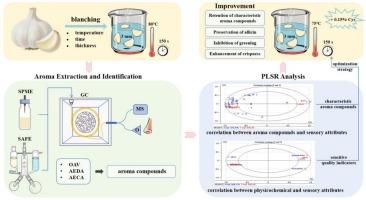Identification of characteristic aroma compounds in blanched garlic through multidimensional analysis and improvement of sensory quality via cysteine-assisted mild blanching
IF 8
1区 农林科学
Q1 FOOD SCIENCE & TECHNOLOGY
引用次数: 0
Abstract
The characteristic aroma compounds in blanched garlic were investigated by solid-phase microextraction (SPME) and solvent-assisted flavor evaporation (SAFE) combined with gas chromatography–mass spectrometry/olfactometry (GC–MS/O). SPME effectively extracted highly volatile, weakly polar, and solvent-sensitive compounds like dimethyl disulfide and 5-hydroxymethyl-2-furfural, while SAFE being more apt to enrich sulfur-containing and heterocyclic compounds such as methyl allyl trisulfide and 3-vinyl-1,2-dithiacyclohex-5-ene. Twenty-eight compounds were identified as crucial aroma compounds through odor activity value (OAV), aroma extract dilution analysis (AEDA), and aroma extract concentration analysis (AECA). Diallyl sulfide, nonanal, and thiophenol were identified only by AEDA, whereas methyl(1E)-1-propenyl disulfide and 2,5-dimethylthiophene were exclusive to AECA. Partial least squares regression (PLSR) analysis further revealed that 2-vinyl-4H-1,3-dithiine, 3H-1,2-dithiole, and methyl allyl disulfide were the predominant contributors to garlic aroma, identifying overlooked key aroma compounds by traditional methods. Different sulfur-containing compounds exhibited synergistic or masking effects that collectively shape the aroma profile of blanched garlic. Greening index, allicin, and fracturability were identified as critical indicators for the blanched garlic process by PLSR. Blanching at 75 °C combined with 0.15 % cysteine increased allicin retention by 49.58 % along with effectively inhibiting greening and enhancing crispness.

多维度分析鉴定焯水大蒜特征香气化合物及半胱氨酸辅助温和焯水改善感官品质
采用固相微萃取(SPME)、溶剂辅助风味蒸发(SAFE)、气相色谱-质谱联用(GC-MS /O)技术对焯水大蒜的特征香气成分进行了研究。SPME有效地提取了高挥发性、弱极性和溶剂敏感性的化合物,如二甲基二硫化物和5-羟甲基-2-糠醛,而SAFE更倾向于富集含硫和杂环化合物,如甲基丙烯三硫化物和3-乙烯基-1,2-二thiacyclohex-5-烯。通过气味活性值(OAV)、香气提取液稀释度分析(AEDA)和香气提取液浓度分析(AECA)鉴定出28个关键香气化合物。二烯丙基硫醚、壬醛硫醚和噻吩仅被AEDA识别,而甲基(1E)-1-丙烯二硫醚和2,5-二甲基噻吩仅被AECA识别。偏最小二乘回归分析(PLSR)进一步揭示了2-乙烯基- 4h -1,3-二硫胺、3h -1,2-二硫醚和甲基烯丙基二硫醚是大蒜香气的主要贡献者,识别了传统方法忽略的关键香气化合物。不同的含硫化合物表现出协同或掩蔽效应,共同塑造了焯水大蒜的香气特征。绿色指数、蒜素和可破碎性是用PLSR法确定的大蒜焯水工艺的关键指标。在75°C下焯水,加入0.15%的半胱氨酸,大蒜素保留率提高了49.58%,有效地抑制了变绿,提高了脆度。
本文章由计算机程序翻译,如有差异,请以英文原文为准。
求助全文
约1分钟内获得全文
求助全文
来源期刊

Food Research International
工程技术-食品科技
CiteScore
12.50
自引率
7.40%
发文量
1183
审稿时长
79 days
期刊介绍:
Food Research International serves as a rapid dissemination platform for significant and impactful research in food science, technology, engineering, and nutrition. The journal focuses on publishing novel, high-quality, and high-impact review papers, original research papers, and letters to the editors across various disciplines in the science and technology of food. Additionally, it follows a policy of publishing special issues on topical and emergent subjects in food research or related areas. Selected, peer-reviewed papers from scientific meetings, workshops, and conferences on the science, technology, and engineering of foods are also featured in special issues.
 求助内容:
求助内容: 应助结果提醒方式:
应助结果提醒方式:


